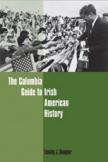A Complex Experience
Most Irish Americans have the impression that the history of Irish America began in the 19th century, when over three million Irish, mostly Catholic, emigrated to the United States. That is false. This history began in the 18th century, when thousands of Irish, mostly Protestant, emigrated to British North America. Timothy Meagher’s history emphasizes this point and much more. The book is more than a narrative history. It is a reference work that includes a history of Irish America from the 18th century to the 21st century, several chapters that discuss issues and themes in that history, a guide to important people and organizations and a chronology of significant events both in Irish and Irish-American history. The last part of the book is an excellent annotated listing of the best books and articles related to Irish-American history. Anyone interested in the history of Irish America will welcome this book.
The theme that ties the narrative history together is identitywhat it means to be Irish-American. Meagher, an associate professor of history at The Catholic University of America, is at his best in analyzing this issue of identity as it has changed over the course of three centuries. This is his most original and valuable contribution to the study of Irish-American history.
By 1790 over 400,000 Irish men and women lived in the United States. Most of them had come from the province of Ulster in the north of Ireland. Protestants, mostly Presbyterians, far outnumbered Catholics at this time. Both groups left their homeland for the same reasonsreligious discrimination perpetrated by the Anglican Church of Ireland and economic hard times. Both Catholics and Presbyterians proudly identified themselves as Irish. It was an inclusive term at this time. One of the more remarkable groups of immigrants were the exiles from the failed uprising in 1798. Protestant and Catholic, they had a dream of a united Ireland independent of British rule. Lawyers, journalists and politicians, they became the leaders in Irish-American communities scattered up and down the East coast. Intensely nationalist, they sowed the seeds of Irish-American nationalism that would last for more than 200 years.
Irish-American history changed decisively in the early 19th century, when Catholic immigrants began to outnumber Protestants for the first time. This was the moment when the term Scotch Irish became the chosen badge of identity for Irish-American Protestants. Irish was no longer an inclusive term applicable to both Catholic and Protestant. Henceforth, to be Irish in the United States was to be identified as Catholic. Meagher discusses the Great Famine and the culpability of the British government in this human tragedy, as well as the great exodus from Ireland that followed. The immigration of thousands of poor, starving Catholic peasants widened the chasm between Catholic and Protestant Irish in the United States. As Meagher puts it, Irish Americans were clearly now a distinct people. The Catholic Church, the Democratic Party, and fierce Irish nationalism defined them as different. The Orange riots in New York City in 1870 and again in 1871 between Protestant and Catholic Irish made clear that there could never again be an Irish America including Protestants and Catholics.
By the end of the 19th century, the American-born Irish outnumbered the foreign-born Irish. With this shift came the emergence of a new identity. The Irish Paddy became the American Patriot as St. Patrick’s Day became the Fourth of July. Linked to this strong Americanism was a militant Catholicism formed during years of religious conflict with Protestant bigots. Most Irish-Americans now identified themselves as militant American Catholics. Religion had trumped ethnicity as the key badge of self-identity. This would remain true for most of the 20th century. Though they controlled the government of numerous cities and held prominent positions in state and federal governments, Irish Catholics were still outsiders because of their religion. The elite clubs and educational institutions of Protestant America were off limits for all but a few of the nation’s Irish Catholics. Meagher believes that John F. Kennedy’s election and assassination would clearly signal the end of an Irish America that had been born when Kennedy’s great-grandfather left Dunganstown during the famine. Irish America had reached its apogee with the election of an immigrant’s great-grandson to the presidency of the United States.
In the closing decades of the 20th century, Irish-American identity changed radically. Allegiance to Catholicism weakened, loyalty to the Democratic Party became problematic, and subsequently a variety of meanings of Irish-American identity opened up. In discussing these options, Meagher concludes his narrative with the claim there were many ways to be Irish American now, for there was no agreement or consensus on what it meant to be Irish in America.
The second part of the guide is less satisfying. Meagher discusses issues in Irish-American historygender, politics, nationalism and racethat intrigue historians. The author’s narrative would have been much better if these important themes had been integrated more fully into the main story rather than left as appendices. For example, he skims over the political culture of the Irish and never offers the reader an appreciation of the colorful personalities who distinguished this slice of Americana. This absence of the human dimension is a major weakness of Meagher’s history.
Without question the relations between African-Americans and the Irish has been one of the most antagonistic inter-group relationships in American history. Meagher makes a sound attempt to explain why this was so, and covers race and the whiteness debate quite well.
One item in the Chronology of Irish America that intrigued me was the All Ireland Irish Football Final, played in the Polo Grounds in New York City in 1947. Surely that underscores how closely allied Ireland was to the Irish-American community. Can anyone imagine baseball’s World Series being played in London? This is but one gem of information contained in this valuable reference work.
This article also appeared in print, under the headline “A Complex Experience,” in the October 10, 2005, issue.








